| SUPPORT TOPICS | Question & Answer Forum - VR |
Maintenance/Support Service Related Information |
| UC-win/Road |
| How to mix one-way traffic and two-way traffic |
Method1: Connecting ramp with road
You create the two-way traffic which end until the end point and then connect one-way traffic with them by ramp. This way can switch the two-way traffic to the one-way traffic. In the case that two-way traffic starts again, first of all, you create two blocks of two-way traffics and connect one-way traffic with them between them.
Method2: Using intersection
You need to define two traffics individually In the case that two-way traffic switch to one-way traffic at the intersection, it is better to use an intersection. You create the intersection at the road which cross two roads. You need to overlay the one(two)-way traffic on the two(one)-way traffic to cross the roads each other. Defining a driving route in the intersection allows you to run either traffic flow or driving simulation.
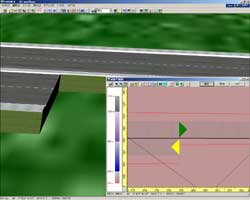 |
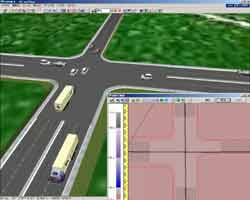 |
|
Page Top

| SUPPORT TOPICS | Question & Answer Forum - Dynamic Analysis | Maintenance/Support Service Related Information |
| UC-win/FRAME(3D) |
| Push-over analysis with fiber elements |
As to the stress-strain curve of type 2 described in the specifications for highway bridges PartćX Seismic design, ultimate displacement of concrete become bigger than the displacement reached at the maximum compressive stress, because of the lateral constraint of lateral tie. In other words, the stress- strain curve is minus curve until the concrete reach at the ultimate displacement from the maximum compressive stress.
When the case a post-peak region have to be considered, the loading by not a force A but forced displacement needed to imposed.
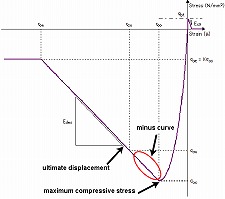 |
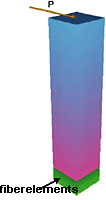 |
Here, the crown of the single pole (shown Fig.2) is loaded by force and displacement and the results are compared.
Fig.3 shows that the load-displacement curve of the crown of the pole, loaded by the two ways: force and displacement.
In the case loaded by force, it doesn't converge at the point of the 40mm displacement. On the other side, in the case loaded by displacement, it converges at all steps. It is thought that un-equilibrium force become bigger and divergence, for the strength degradation of the resistible concrete, although the stress-displacement curve of concrete become the minus curve at the point over 40mm and increase gradually.
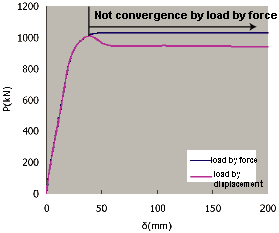 |
Here introduced that when there are the minus curve in the hysteresis of fiber elements, the load way increasing lateral force gradually doesn't converge. The way of giving the forced displacement is useful. Remember that this way is also useful when there are the minus curve in the M-āė characteristic of M-āė elements, not limited to the fiber elements.
 |
 |
 |
||
| BACK | INDEX | NEXT |

